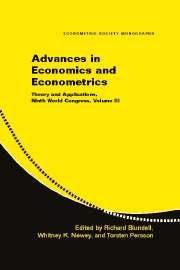Book contents
- Frontmatter
- Contents
- Contributors
- Introduction by the Editors
- 1 Identification of Nonadditive Structural Functions
- 2 Nonadditive Models with Endogenous Regressors
- 3 Heterogeneity and Microeconometrics Modeling
- 4 Heterogeneous Choice
- 5 Modeling Heterogeneity
- 6 Inference with Weak Instruments
- 7 Empirical Likelihood Methods in Econometrics: Theory and Practice
- 8 Weak Instruments and Empirical Likelihood: A Discussion of the Papers by D. W. K. Andrews, J. H. Stock, and Y. Kitamura
- 9 Estimating Continuous-Time Models with Discretely Sampled Data
- 10 Variation, Jumps, and High-Frequency Data in Financial Econometrics
- 11 Discussion of Aït-Sahalia and Barndorff-Nielsen and Shephard
- 12 Understanding Bias in Nonlinear Panel Models: Some Recent Developments
- 13 Fixed and Random Effects in Nonlinear Panel Data Model: A Discussion of a Paper by Manuel Arellano and Jinyong Hahn
- Index
- Titles in the series
10 - Variation, Jumps, and High-Frequency Data in Financial Econometrics
Published online by Cambridge University Press: 05 January 2013
- Frontmatter
- Contents
- Contributors
- Introduction by the Editors
- 1 Identification of Nonadditive Structural Functions
- 2 Nonadditive Models with Endogenous Regressors
- 3 Heterogeneity and Microeconometrics Modeling
- 4 Heterogeneous Choice
- 5 Modeling Heterogeneity
- 6 Inference with Weak Instruments
- 7 Empirical Likelihood Methods in Econometrics: Theory and Practice
- 8 Weak Instruments and Empirical Likelihood: A Discussion of the Papers by D. W. K. Andrews, J. H. Stock, and Y. Kitamura
- 9 Estimating Continuous-Time Models with Discretely Sampled Data
- 10 Variation, Jumps, and High-Frequency Data in Financial Econometrics
- 11 Discussion of Aït-Sahalia and Barndorff-Nielsen and Shephard
- 12 Understanding Bias in Nonlinear Panel Models: Some Recent Developments
- 13 Fixed and Random Effects in Nonlinear Panel Data Model: A Discussion of a Paper by Manuel Arellano and Jinyong Hahn
- Index
- Titles in the series
Summary
INTRODUCTION
We will review the econometrics of nonparametric estimation of the components of the variation of asset prices. This very active literature has been stimulated by the recent advent of complete records of transaction prices, quote data, and order books. In our view the interaction of the new data sources with new econometric methodology is leading to a paradigm shift in one of the most important areas in econometrics: volatility measurement, modeling, and forecasting.
We will describe this new paradigm which draws together econometrics with arbitrage-free financial economics theory. Perhaps the two most influential papers in this area have been Andersen, Bollerslev, Diebold, and Labys (2001) and Barndorff-Nielsen and Shephard (2002), but many other papers have made important contributions. This work is likely to have deep impacts on the econometrics of asset allocation and risk management. One of the most challenging problems in this context is dealing with various forms of market frictions, which obscure the efficient price from the econometrician. Here we briefly discuss how econometricians have been attempting to overcome them.
In Section 2, we will set out the basis of the econometrics of arbitrage-free price processes, focusing on the centrality of quadratic variation. In Section 3, we will discuss central limit theorems for estimators of the QV process, while in Section 4, the role of jumps in QV will be highlighted, with bipower and multipower variation being used to identify them and to test the hypothesis that there are no jumps in the price process.
- Type
- Chapter
- Information
- Advances in Economics and EconometricsTheory and Applications, Ninth World Congress, pp. 328 - 372Publisher: Cambridge University PressPrint publication year: 2007
- 49
- Cited by



